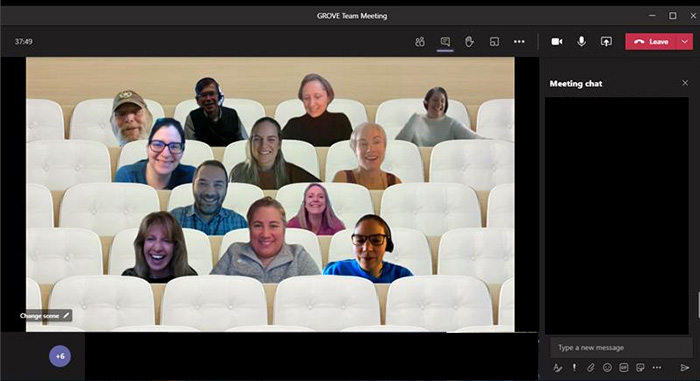 |
Growing Rural Outreach through Veteran Engagement (GROVE)HSR&D’s monthly publication Veterans’ Perspectives highlights research conducted by HSR&D and/or QUERI investigators, showcasing the importance of research for Veterans – and the importance of Veterans for research. In the December 2021 Issue:
|
Introduction
The GROVE team wants to know how it can help HSR&D investigators incorporate and support Veteran engagement methods in their research. Contact Kelty Fehling, Ray Facundo, or Leah Wendleton for an initial consultation.
The Center for Growing Rural Outreach through Veteran Engagement (GROVE) is a novel resource for HSR&D researchers who want to use engagement methodology in their projects. GROVE develops capacity and resources for VA researchers and staff to be more inclusive of rural Veteran populations and to serve as a resource center to support projects interested in including Veteran engagement in their methods. Nearly a quarter of US Veterans live in rural areas, with approximately 60% of those rural Veterans enrolled in VA care. However, much of the HSR&D research portfolio has not benefited from formal rural Veteran input due to researchers typically being located in urban regions that have co-located VAMCs and academic institutions. GROVE was created as a VA resource center to address this challenge and continue to grow Veteran engagement best practices. GROVE staff members have worked to promote Veteran engagement in HSR&D research for over a decade via the HSR&D Veteran Engagement Workgroup, at the Center of Innovation (COIN) level, and by incorporating Veteran engagement methods in their own HSR&D-funded research. They have learned that Rural Veterans’ expertise and lived experience can inform VA research projects at all stages - from recruitment and identification of eligible Veterans to the dissemination of learning and interventions. Much of GROVE’s work is consultation, outreach, and partnership building between rural communities, rural Veterans, and VA researchers. 
The GROVE Team: (top row) Mark Flower, Jeff Whittle, Paige Backland-Jarquin, Kenda Steffensmeier (second row) Leah Wendleton, Katie LaChappelle, Gala True (third row)Ray Facundo, Kelty Fehling (bottom row) Kady Nearing, Sarah Ono, Amber Lane ConsultationIn its first year, the GROVE team provided expert consultations for two HSR&D Career Development Award (CDA) submissions, the HSR&D Access Consortia of Research (CORE), and an HSR&D Innovation Award.
“The topic of approaching Veterans as professionals but keeping communication informal was something I had not thought about before! It's an excellent way to describe the balance needed.” – VA Investigator Jam SessionsJam Sessions are informal “community of practice” forums where clinicians, investigators, and research staff working in Veteran engagement can seek and provide solutions to problems they encounter. The name was adopted from the practice of like-minded musicians getting together to share ideas and collaborate. Jam sessions grew organically out of HSR&D’s prioritization of Veteran engagement, but GROVE team members formalized a process to collect and understand the needs of the VA community doing Veteran engagement. During meetings, less experienced professionals are encouraged to share barriers they have hit and participate in discussions with researchers who have more experience in Veteran engagement. This process allows for the GROVE Center to hear what tools and support the community needs to improve their work. Jam sessions are currently held monthly during the summer, virtually over Microsoft Teams. GROVE staff plan a series of topics in advance and send out flyers to past participants. A core group of facilitators including investigators, research staff, and Veteran advisors attend every meeting to help lead conversations. Participants are encouraged to ask questions, contribute to discussions with peers, and network with others in the Veteran engagement community. “Hearing the experiences of others has been really helpful… (T)o have some ideas when things pop up of what others have done is like having a tool ready just in case. ” – Jam Session participant 
SERVE ToolkitThe Strengthening Excellence in Research through Veteran Engagement (SERVE) Toolkit supports VA research centers and investigators in efforts to include Veterans and other stakeholders in the development, implementation, and dissemination of research studies. Several members of the GROVE team assisted with the collaborative effort between VA hospitals where research using Veteran engagement was a priority, culminating in the web-based SERVE Toolkit. GROVE now works to update this website, adding tools and processes developed in their projects and addressing gaps identified during consults and Jam sessions. “I think that engagement with Veterans during the planning stage really informs a nuanced approach...(and) there will likely be more uptake on services that we're designing...” – HSR&D funded investigator “Being involved with GROVE allows me to help create better research, hopefully leading to better results for my fellow Veterans” – Veteran, Research Advisor Next StepsVirtual Platform: Part of GROVE’s mission is to connect researchers and Veterans by developing virtual processes to facilitate Veteran engagement in rural settings. GROVE’s future website will provide a setting for interested Veterans to learn about Veteran engagement, connect with researchers who have promoted their projects on the virtual platform, and network with other Veterans. SERVE Toolkit: GROVE is currently working on an update to the SERVE Toolkit website, with rural engagement strategies and templates, virtual best practices, technology distribution, facilitation resources, visual elicitation resources, additional compensation options, and VSO engagement best practices. |